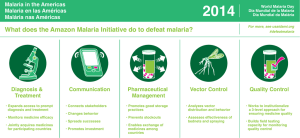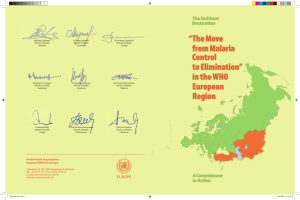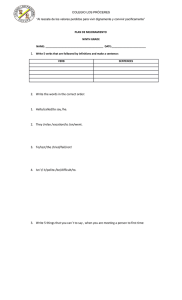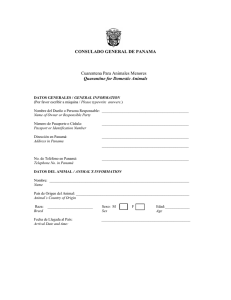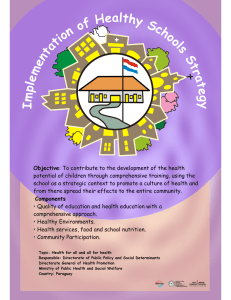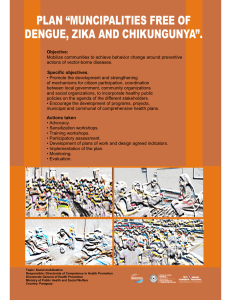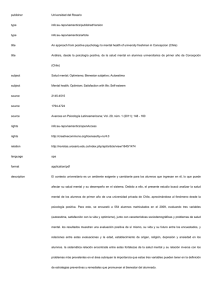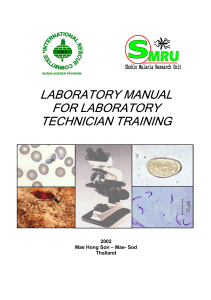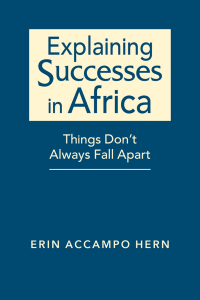Action and Investment to defeat Malaria (AIM)
Anuncio
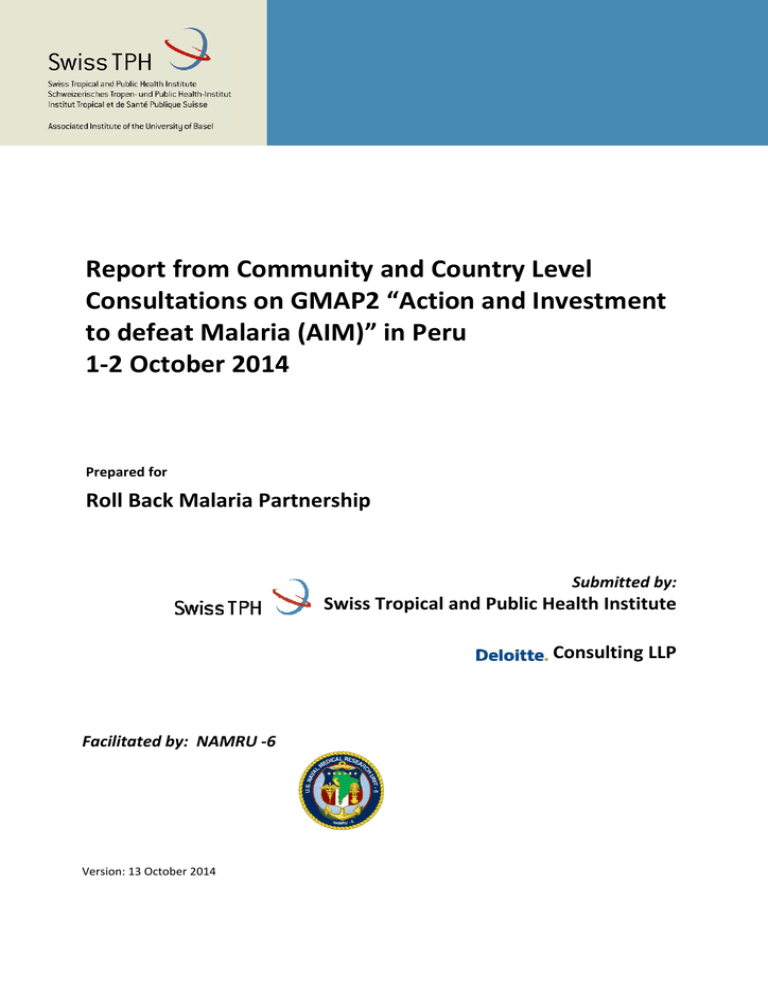
Report from Community and Country Level Consultations on GMAP2 “Action and Investment to defeat Malaria (AIM)” in Peru 1-2 October 2014 Prepared for Roll Back Malaria Partnership Submitted by: Swiss Tropical and Public Health Institute Consulting LLP Facilitated by: NAMRU -6 Version: 13 October 2014 Abbreviations AIM Action and Investment to defeat Malaria CHW Clinical Health Worker GMAP Global Malaria Action Plan ENSO El Nino-Southern Oscillations IRS Indoor Residual Spraying ITN Insecticide Treated Nets MCH Materna and Child health M&E Monitoring and Evaluation MINSA Ministerio de Salud MOH Ministry of Health PAHO Pan American Health Organization P. falciparum Plasmodium falciparum P. vivax Plasmodium vivax RDT Rapid Diagnostic Test Swiss TPH Swiss Tropical and Public Health Institute TB Tuberculosis USAID United States Agency for International Development WHO World Health Organization 2 1. Introduction The country consultation in Peru was convened by the U.S. Naval Medical Research Unit No. 6 (NAMRU6), Perú which organized the meeting jointly with the Ministry of Health (MoH), the Pan American Health Organization-Peru (PAHO) and further assistance from USAID. The consultation was facilitated by Dr. J. Luis Segura a member of the Swiss TPH/Deloitte AIM consultant team, who also helped to facilitate the regional consultation for South and Central America in Panama earlier this year. Malaria in Peru is endemic in the Amazonian basin and the tropical north coast. 35% of the population, residing across a geographical expanse that makes up 75% of the Peruvian territory, are at risk of malaria. Currently, 90% of malaria cases are caused by P. vivax. The consultation process included engagement visits to Loreto and Piura regions. Loreto is located in the Amazonian basin and has experienced an increasing a substantial increase of malaria during 2012-2014, whereas Piura is located on the tropical northern coast where malaria has been mostly under control since 2000, although it remains at risk of imported cases and possible outbreaks. During the engagement visits community members, government representatives, health workers and health authorities were consulted. The consultative meeting was held in Lima, the Peruvian capital city, with 30 participants, including officials from the MoH from the central level and from 6 regions, as well as representatives of the Ministries of Agriculture, Housing, Construction and Sanitation, the Environment and Transport, PAHO, USAID, Universidad Peruana Cayetano Heredia, NAMRU-6, and one oil company (PlusPetrol). 1.1 Community Consultation Overview The engagement visits to Loreto and Piura regions were scheduled on 26-27th and 29th September respectively. Loreto Region covers almost one-third of Peru's territory. Located in the northeast, is by far the nation's largest region; it is also one of the most sparsely populated regions due to its remote location in the Amazon Rainforest, sharing extensive borders with Ecuador, Colombia and Brazil. Piura Region is a coastal region located in the northwest of the country, just 4 degrees south of the equator, with a warm tropical weather around the year. Because of its fragile geo-climatic situation, this region is severely affected by El Nino-Southern Oscillations (ENSO), which has been associated with malaria outbreaks. Discussions were firstly held with 20 people at village level including: • Community members • Community Health Volunteers • Front line workers (Lab technician, nurses, medical doctors) • Regional Malaria control program authorities. A list of participants can be found in Annex 1. Pictures of the engagement visits and the consultative meeting in Lima can be found in Annex 5. 1.2 Background information Loreto comprises nearly one-fourth of the land mass of Peru, and has the ecologic characteristics of the Amazonian lowlands. Iquitos is its only large urban center in Loreto, is accessible only by air or river. The total population is around 1 million people, with approximately 40% residing in Iquitos. The remainder population is highly dispersed in 2,600 towns and villages throughout the Amazon tributary system. Up to 28 ethnic groups are present in the region. According to the 2013 Demographic and Health Survey 2012-13 (ENDES 2013), Loreto was the region with the highest child mortality rate (46 per thousand live births), the second highest infant mortality rate (33), and also the highest fertility rate (3.8). The same source reported that Piura had an infant mortality 3 of 17 per thousand live births, and a fertility rate of 3.0, where the national averages were 19 and 2.4 respectively. Historically, Loreto contributes 80% of the national burden of malaria cases. After a re-emergence during the decade of 1990s which reached more than 100,000 malaria cases per year, the next peak was observed in the 2002 with 65,727 cases, with then a decreasing trend which started in 2005 and ended in 2010 (11,453). In 2013 a total of 43,456 cases were registered and so far 2014 seems will be the fourth year with a crescent number of cases. Since 2011, ases of P. falciparum tripled and P. vivax doubled. The main malaria control activities include passive surveillance, and the screening and treatment of villages with parasite rates higher than 5%. Focalized IRS and bednets distribution are also implemented in certain periods. Since 2010 when PAMAFRO, a regional project funded by Global Fund, ended, there was a long delay until a process for establishing RDTs could be established. Piura is historically considered an important focus of malaria transmission in Peru, however a sharp reduction in the number of cases has been experienced (2,153 cases in 2010 to 15 cases in 2013). The decrease in the number of cases and the emergence of another outbreaks (dengue) has led to a considerably reduction in malaria control activities in the region. 1.3 Summary of key themes emerging from engagement visit and implications for AIM Malaria is not a priority for local and regional governments or the general population, even in areas with a re-emergence. All those consulted agreed not enough sustained efforts are oriented to control malaria. At the regional government level, malaria and other transmissible diseases only receive attention under the pressure of the media when outbreaks become out of control; and at the district/community level, malaria control activities are rarely prioritized. As consequence of the decentralization process which was completed in 2008, the MoH activities in Loreto and Piura Regions are funded, as in other regions of the country, via a budget that is under the control of the Regional Government. Since 2010, the budget for control of transmissible diseases – which is a packet, and not specific disease based-, is included among the strategic programs to be funded through the “results based budget”; which is approved after a cost/benefit assessment of the Ministry of Finances. Under this setting the allocation of budget to malaria control activities depends upon the amount of money obtained for transmissible diseases, and the regional prioritization among transmissible diseases. According to senior MoH officers at the regional level, the budget available for malaria is limited by the Ministry of Finance’s tendency to provide less than requested funds, and the intra-regional allocation of funds to the outbreaks that gain most visibility in terms of public opinion. According to MoH officers, regional governments lack the political will and/or the technical capabilities to negotiate these budgets effectively with the Ministry of Finance; and there are no targets for malaria control activities beyond those related to budget execution. In consequence, resources to keep malaria control efforts in absence of outbreaks or political visibility are scarce and at high risk of being reassigned. The health workers and highly experienced community health workers who were consulted, reported that communities only become involved in malaria control activities under external leadership provided by special projects (e.g. PAMAFRO) or charismatic local health authorities. This would be related to the multiple and intense challenges related to the economic activities (e.g. transport for crops), limited access to services (e.g. schools), and another diseases (e.g. dengue) in a context where malaria severe is uncommon. Implications: AIM must provide a framework for investing in malaria in regions where malaria is not a public opinion priority, given that the occurrence of severe cases is uncommon, the 4 presence of other outbreaks, and constraints on economic activities of population on risk. It is particularly important that AIM highlights the economic returns of investments in malaria, in messages oriented to regional, local and community decision makers. AIM should also provide guidance about how to leverage domestic resources, by making the case to Ministry of Finance officers about the high return of malaria control activities, using evidence based advocacy. AIM could propose an operational research agenda to the countries to strengthen the evidence needed to guide the choice and intensity of interventions. Not enough awareness about the relationship between malaria control and development. Community health volunteers and front line health workers both highlighted how malaria control is not included among the regional/local/community investments considered contributory to local development. In the rural community visited in Loreto, some families depend on ecological lodges receiving tourists and the production of handcraft; yet it seems that the risk of the dissuasive effect of malaria on tourism is not clearly perceived at the community, local or regional level. In the peri-urban community visited in Piura, social problems such as violence, drug consumption, unemployment, or health problems resulting from dengue outbreaks, are given more priority than malaria by the general population. The discussions with community members showed that families see issues related transport, security, education and employment as being more immediately related to community development, than current or previously endemic diseases like malaria. Government funded malaria control actions are reactive to resurgence of cases. This seems to be broadly in line with population expectations and considered to be yet another suboptimal public service. In the communities visited, no private actors were involved in malaria control. Implications: AIM must provide guidance about how to raise awareness about malaria control as a cost/effective intervention to further development at the community, district and regional level in settings where severe malaria is uncommon, or malaria is under control but the risk of resurgence persists. Long experience of community participation: Due to the high dispersion of population in the Amazonian basin and the limited availability of health services, the MoH has called, recruited and trained community health volunteers since many years. Front line health workers expressed many times their satisfaction with their collaboration, and rely on them for diverse activities, including but not limited to malaria control. Community health volunteers in turn expressed their dissatisfaction as they no longer receive incentives as in the past, to cover their transport and food expenses. In Loreto, the previous experience with a project (PAMAFRO) which used to provide this kind of support to community volunteers was mentioned as having been the ideal situation. Aside of PAMAFRO, the mobilization of community members to perform environmental management activities were reported to be the consequence of the leadership of specific health service authorities, and not as regular MoH activities. Additionally, with the improvement of Peruvian economy, now community health workers more frequently find paid employment opportunities, so completely unpaid volunteer work is becoming a less viable scenario. In both settings (Loreto and Piura), community health workers acknowledge MoH staff as their “superiors”, and showed their readiness to follow instructions. There are no mechanisms in place to make the MoH staff accountable to the community health workers, or to the community in general. The MoH services performance is reported internally only, and these reports are oriented to monitor budget execution and the number of services provided, do not including the accomplishment of public health targets. Implications: AIM must provide guidance on how to empower communities to ensure a more horizontal participation and to strengthen their involvement in monitoring the achievement of public health targets and performance assessments. AIM should also acknowledge the economic 5 costs related to community participation in malaria control, as well as the non-financial motivations of community health workers. Diagnosis and treatment need to be available when and where required. In Loreto the community health workers and front line health workers mentioned the challenges to provide timely diagnosis and treatment to every fever case. Many villages are hours away of health facilities, and those with higher parasite rates are screened by field teams 2-3 times per year at best. The high cost of this last activity is evident for everybody, but there was little evidence of its impact on the disease burden. Community health workers expressed their willingness to use rapid diagnostic tests, and to provide treatment, as many of them did during PAMAFRO project. However, the MoH is not procuring RDTs any more, relying in microscopy testing offered by health facilities and by mobile teams. Implications: AIM must provide adequate guidance to choose malaria control activities taking in consideration the available resources, in particular where specific challenges such as dispersed populations prevail. 2. Overview of the consultative meeting nd The consultative meeting was convened in Lima-Peru on 1-2 October 2014. A total of 30 participants took part from Loreto, Junín, Ayacucho, Tumbes, Madre de Dios, Lambayeque, and the central level from diverse organizations. The participants came from central and regional government sectors, a large private company, research and academia, as well as from amongst the development partners. The agenda of the two day meeting can be found in Annex 2. 2.1 Objectives of the consultative meeting The main objectives of the community level consultation were to: Enable participants to set the agenda for the next iteration of the Global Malaria Action Plan Help to better understand how to position malaria within the country’s broader development context Learn how other programs have successfully engaged communities e.g. Polio, HIV/AIDS, TB, MCH etc. Create a shared understanding of the current status of the country’s response to malaria Identify high priority actions for progress towards control/ elimination goals Identify areas where the AIM could usefully provide guidance to accelerate action Sensitize country stakeholders for the future implementation of AIM Network, build relationships, and identify new opportunities for partnership. 2.2 Key national opportunities and challenges prioritized for discussion After the official opening and introduction to the AIM process, a presentation was given on the engagement visits and the observations from the discussions with community members, community development workers, first line health workers and district and state level respondents during the engagement visit. In addition, the findings from the PAHO regional consultation were also briefly presented. In a moderated session the participants jointly agreed on three topics that they thought it would be most beneficial to discuss during the consultation. These topics were: 1. Multisectorial actions in malaria control 2. Management and Budget 3. Access to health services 6 2.3 Summary of key points emerging from the consultative meeting The participants worked in two multi-constituency groups including for example, representatives of Government, Development Partners, Research, Civil Society and the Private Sector. Firstly, the different ways being invested in the fight against malaria were outlined by various constituencies. After this, each topic was discussed in the group. The participants described what was currently being done from their constituency and how well it was working. After each session the groups did a gallery walk and looked at the results of the discussions from the other groups. The participants then proceeded to prioritise actions to enable them to move forward on this topic. The list of priority actions is in Annex 3. Leveraging resources from all sectors with a role in malaria control: Attendants acknowledged that collaboration between sectors are bilateral, sporadic, related to specific interests, and not following broader priorities or a multisectoral plan. The MoH at the central level was considered to be the natural leader for calling for greater multisectoral participation, at the central and regional level. The performance based budget was identified as a space where multisectoral action, using domestic funds already available. So the audience for these efforts include at least the Ministries of Finance, Housing, Environment and Education. The participants emphasized the importance of academia’s contribution regarding best practice of multisectoral action as well as evidence of its benefits. Development partners could provide technical assistance and resources to the MoH on how to more effectively lobby the Ministry of Finance and Regional Governments about investment in malaria control/elimination. Management and budget: An urgent need for improvements was noted to be required in the malaria planning (central and regional planning is not articulated enough), budgeting (vector transmitted diseases offices at the regional and central level lack enough human resources), and procurement (procurement of ITN took three years). Moreover, some critical malaria control activities (e.g. epidemiological surveillance) are not eligible to be funded by the performance based budget, which is the main available budget source. Currently the Minister of Finances does not support sustained investments in malaria control, when the number cases is reduced; probably because the economic benefits of this has not been adequately elaborated or communicated. Sometimes, by the time the budget becomes available it is too late to execute a preventive approach, or to ensure continuity in the availability of supplies and human resources. These uncertainties also increase the turnover of the MoH staff, affecting its managerial capacity. Accessibility of health and malaria services: The combination of the high dispersion of population in the Amazonian basin and the lack of health infrastructure in these remote settings on Peru’s territory presents a formidable challenge to health service delivery. Currently private companies provide logistic support to the MoH, but the impact of those contributions could be enhanced by improved planning and coordination. In the context of decentralization, local governments could take steps to incentivize a territory based management approach which could help to ensure adequate coverage of services to dispersed populations. The experience involving community health workers was considered successful by all participants, but this has not been supported adequately since the end of PAMAFRO project. The allocation of public resources through the performance based budget to support CHW working in other diseases (e.g. TB, 1 HIV/AIDS ) was proposed as a model to follow. 1 Community-based DOT-HAART accompaniment in an urban resource-poor setting. Muñoz M, Finnegan K, Zeladita J, Caldas A, Sanchez E, Callacna M, Rojas C, Arevalo J, Sebastian JL, Bonilla C, Bayona J, Shin S.AIDS Behav. 2010 Jun;14(3):721-30. doi: 10.1007/s10461-009-9559-5. Epub 2009 Apr 16. 7 After the three group discussions, the plenary considered where action could be taken immediately, and where guidance from AIM or another source would first be needed. Given the interest of MoH officers in the meeting, the participants decided to produce a document with recommendations that could be implemented immediately, and others that could be pursued after the launch of AIM. 2.4 AIM could potentially provide useful guidance on how to: Position malaria control/elimination activities as cost effective interventions so to make the case for these investments convincing the Ministry of Finances and other sectors. Advocate effectively to the multiple government sectors, regional and local governments and general population. Encourage operational research which provides evidence immediately useful to malaria control implementers. Implement accountability mechanisms for investments in health and development from public and corporate sources To generate evidence, and establish best practices and ensure that these are taken up in policy recommendations Incorporate community based resources in an effective way. 3. Assessment of the success of the consultative process Feedback given by the participants was positive. Both the organisers and the participants were grateful to have been consulted and thought that the discussions had been very rich. A contact list was shared with all participants and the meeting already seemed to have tangible benefit by providing a platform for convergence of stakeholders from different regions and sectors. “The challenges imposed by malaria control in our country requires we continue these discussions beyond this meeting, so to find innovative and effective ways of collaboration” Consultation participant’s feedback The attendants decided to produce a document with main conclusions of the event proposing actions to the Ministry of Health, organized in two periods: before and after the availability of AIM. A total of 21 people were spoken to during the engagement visits of which 11 were women (52%). In addition to five organizers, a total of 32 people from 47 invited attended that national consultative meeting (70% attendance rate). This may in part be explained by only one representative per institution attending (the case for many MoH regional officers), or by their involvement in the regional elections (representative of productive organizations as loggers). Among the total of participants 35%(13/37) were female, 41% (15/37) of them were from national MOH central level (vice-minister, other senior officers, national malaria program, other departments), 16% (6/37) were from MOH regional level, 16% (6/37) from academy/research, 14% (5/37) from another government sectors (environment, housing, agriculture, transport), 8% (3/37) from private sector and 5% (2/37) from technical agencies (PAHO and USAID). The participants list can be found in Annex 4. 8 Annex 1: Engagement visit participant list Engagement visit in Loreto 1 (San Andres) Dr. Wilder Arbildo Malaria Control Program - Coordinator Dra. Wilma Casanova Dr. Carlos Alvarez Vector Transmitted Disease Strategy Director Epidemiologist Paolo Colompo Community Health Volunteer Irene Mozambite Community Health Volunteer Roldan Muanze Community Health Volunteer Emilia Malapara Community Health Volunteer Engagement visit in Loreto 2 (Padre Cocha) Ma Eugenia Ricopa Community Health Volunteer Leonardo Portocarrero Community Health Volunteer Delia Rosa Community Health Volunteer Oscar Noriega Community Health Volunteer Walter Cayche Community Health Volunteer Dr. David Hidalgo Macedo HC Responsible Tec. Lab. Aida Esther Quiroz Herrera Lab Technician Lic. Enf. Rosario del Jesus Lopez Pacaya Nurse Engagement visit in Piura Dr. Edward Pozo Regional Epidemiology Director Dr. Walter Wong Health Region Director Dra. Mónica de Belen Melendez Dra Elizabeth Carbajal Sub-Region Sullana Epidemiology Director Bellavista HC – Clinician Juan Nunjar Castillo Community Health Volunteer Norma Gutierrez Sanchez Community Health Volunteer Rosa Elena Chavez Community Health Volunteer Edith Ruez Bellavista HC (responsable of activities) 9 – Technician malaria control Annex 2: Agenda of consultative meeting Tiempo Requerido Mie 1 Oct 8:30-9:00 Sesión Comentarios Llegada y registro de participantes Bienvenida oficial y presentaciones. Mie 1 Oct Dr. Martin Clendenes, Estrategia 9:00-9:45 Metaxénicas Dr. Willy Lescano, NAMRU-6 Se solicitará a los participantes que presenten información relativa a las actividades que realizan actualmente y así proveer una base para las discusiones durante la consulta. Se les pedirá de antemano que aporten material adicional para comentar con otros participantes (posters, trípticos, etc.). ¿Porque considera que la lucha contra la Mie 1 Oct malaria es una prioridad? 9:45-10:00 Moderador: Dr. Willy Lescano, NAMRU-6 Ejercicio de lluvia de ideas, los participantes indicaran sus opiniones hasta llegar a un punto de saturación en el que se repitan ideas previamente planteadas. Orientación sobre el AIM, incluyendo: · Resumen sobre el proceso de desarrollo del AIM. Mie 1 Oct Dr. Segura, Swiss TPH 10:00-10:30 · Nexo con la Estrategia Técnica Global . Dr. Guillermo Gonzalvez, OPS · Propósito de la Consulta de País. Dr. Martin Clendenes, MINSA Antes de la reunión se entregará esta información a los participantes en un resumen de una página. El facilitador valorará brevemente el grado de conocimiento de los participantes con respecto al actual GMAP y en qué modo lo han utilizado. Presentación de las principales conclusiones de la Consulta Regional/análisis de documentos. Mie 1 Oct Metodología para la consulta en Peru. 10:00-11:05 Hallazgos de visitas a comunidades endémicas. Dr. Luis Segura, Swiss TPH Mie 1 Oct Pausa para café 10:05-11:20 Avances en el control y manejo de la malaria en la última década Representante Loreto (10 min). Dr. Cristiam Carey Mie 1 Oct Representante Tumbes (10 min). Dr. 11:20-12:05 Rommel Gonzales Representante Junín (10 min). Dr. Daniel Chuchón Moderador: Dr. Jorge Escobedo, MINSA Preguntas y discusión 10 25 min de presentación, 10 de preguntas 30 min de presentaciones, 15 de preguntas Discusión relativa a los desafíos y oportunidades específicas del país. Dr. Jaime Chang, USAID · ¿Qué tan importantes son esos hallazgos (los de la consulta regional) en tu país? · ¿Existen otros desafíos u oportunidades en la respuesta a la malaria Mie 1 Oct en tu país que también consideres 12:05-12:50 importante discutir? Priorización de desafíos/oportunidades específicas del país. Dr. Willy Lescano, NAMRU-6 · ¿Cuáles son los tres mayores desafíos u oportunidades que tu país afronta en el trabajo para reducir y eliminar la malaria? Mie 1 Oct Almuerzo 12:50-14:05 Sesión 1: Discusión facilitada sobre el primer desafío / oportunidad tal y como ha sido priorizado por los participantes. · ¿Qué haces actualmente para abordar ese desafío o aprovechar esa oportunidad y cómo está funcionando? · Roles principales y posibles contribuciones de los diferentes actores Mie 1 Oct en la implementación del AIM: MINSA, 14:05-15:05 Instituciones académicas/de investigación, otros actores (gobierno, poblaciones afectadas, etc.) · Sabiendo lo que todos los actores están haciendo a este respecto, ¿qué acciones futuras ves ahora necesarias para progresar en tus objetivos de reducción o eliminación de la malaria? Facilitador, Dr. Jorge Escobedo, MINSA Sesión 2: Discusión facilitada sobre el segundo desafío / oportunidad tal y como ha sido priorizado por los participantes. · ¿Qué haces actualmente para abordar ese desafío o aprovechar esa oportunidad y cómo está funcionando? · Roles principales y posibles contribuciones de los diferentes actores Mie 1 Oct en la implementación del AIM: MINSA, 15:05-16:05 Instituciones académicas/de investigación, otros actores (gobierno, poblaciones afectadas, etc) · Sabiendo lo que todos los actores están haciendo a este respecto, ¿qué acciones futuras ves ahora necesarias para progresar en tus objetivos de reducción o eliminación de la malaria? Facilitador, Dr. Guillermo Gonzalvez, OPS 11 El facilitador solicitará a los participantes validar y ampliar las conclusiones de la consulta regional. Después, el grupo priorizará los tres mayores desafíos u oportunidades. Si hay tres sesiones se fomentará la inclusión de al menos una oportunidad. Éstas serán discutidas en las siguientes sesiones. Las sesiones facilitadas ofrecerán, en primer lugar, una oportunidad para los diferentes actores de intercambiar sus experiencias con respecto al punto que se está discutiendo y cómo está funcionando en su entorno. Posteriormente, los actores considerarán acciones futuras necesarias para seguir avanzando (ej. que necesitan cambiar, tanto si se requiere incrementar o disminuir los esfuerzos como cambiarlo completamente). Igual que la anterior Mie 1 Oct Pausa para café 16:05-16:20 Sesión 3: Discusión facilitada sobre el tercer desafío / oportunidad tal y como ha sido priorizado por los participantes. · ¿Qué haces actualmente para abordar ese desafío o aprovechar esa oportunidad y cómo está funcionando? · Roles principales y posibles contribuciones de los diferentes actores Mie 1 Oct en la implementación del AIM: MINSA, 16:20-17:20 Instituciones académicas/de investigación, otros actores (gobierno, poblaciones afectadas, etc) · Sabiendo lo que todos los actores están haciendo a este respecto, ¿qué acciones futuras ves ahora necesarias para progresar en tus objetivos de reducción o eliminación de la malaria? Facilitador, Dr. Jaime Chang, USAID Resumen de lo avanzado en el día. Retos Mie 1 Oct pendientes. Comentarios y discusión. 17:20-17:35 Dr. Luis Segura Mie 1 Oct Fin del día de trabajo. 17:35-17:45 Plan de acción local, siguientes seis meses, antes de la siguiente ‘temporada’ de malaria Moderador: Martin Clendenes, MINSA • Teniendo en cuenta la lista de acciones identificadas, ¿con cuáles podrías empezar a trabajar inmediatamente como país, con los recursos que tienes disponibles? • Roles principales y posibles Jue 2 Oct contribuciones de los diferentes actores 09:00-10:00 en la implementación del AIM: MINSA, Instituciones académicas/de investigación, otros actores (gobierno, poblaciones afectadas, etc) • ¿Qué acciones se beneficiarían de la orientación, buenas prácticas, u otros recursos incluidos en el AIM? • ¿Podrías comentar alguna lección aprendida que pudiera ser relevante para otros países? 12 Igual que la anterior Todos los participantes Esta sección ofrece a los participantes la oportunidad de discutir sobre cómo aprovechar el impulso generado por el encuentro sobre la consulta. Además, provee al Equipo de Consultores del AIM de ejemplos específicos sobre lo que los países necesitan del documento AIM, así como de una oportunidad para identificar posibles estudios de caso para incluir en el documento. 30 min para trabajo en tres grupos, presentación de 5m cada grupos, 15m discusión y preguntas Plan de acción local, siguientes 18 meses, pre-lanzamiento AIM · Que acciones futuras son necesarias para lograr los objetivos de reducción o eliminación de la malaria · Roles principales y posibles contribuciones de los diferentes actores en la implementación del AIM: MINSA, Instituciones académicas/de investigación, Jue 2 otros actores (gobierno, poblaciones 30 min para trabajo en tres grupos, Oct10:00afectadas, etc) presentación de 5m cada grupos, 15m 11:00 · ¿Cuáles de esas acciones se pueden discusión y preguntas empezar a llevar a cabo de forma inmediata con los recursos que hay disponibles? · En relación a aquellas que no se pueden empezar a llevar a cabo, ¿qué se necesitaría de otros sectores, organizaciones, empresas o comunidades para iniciar esas acciones? Moderador: Jorge Escobedo, MINSA Jue 2 Oct Cierre. Dr. Martin Clendenes, MINSA 11:00-11:10 Jue 2 Oct Fin del evento. 11:10 13 Annex 3: Priority Actions identified at the consultation Priority Actions for great multisectoral involvement in malaria • National level of Ministry of Health does advocate to other Government sectors at the national, as well as to the regional governments to call for multisectoral action in the malaria control/elimination. • By including specific items in the performance based budget, to ensure domestic funds provide financial support to activities in public health, education and housing sectors oriented to the malaria control/elimination • To guide multisectoral strategies and actions with high quality evidence (research). Priority Actions to overcome challenges in the availability of funds and its management • To advocate for malaria control/elimination, raising its priority in the national, regional and local development agenda, based in available evidence and proposing realistic, mid and long term targets. • To enhance technical and financial capabilities of the Ministry of Health regarding incidence on decision makers and population, so they can effectively advocate for additional and sustained resources in malaria control/elimination. • To develop a National Plan of Malaria Control/elimination with clear identification of specific roles across sectors. • To enhance technical staff and capabilities of malaria control programs at the national and regional levels. Priority Actions to overcome challenges in the access to malaria related services. • To include cultural, financial and geographical dimensions in definition of access. • To ensure financial support for outreach activities in malaria control. • To provide enough incentives, including money, to community health volunteers. • Low transmission areas should also be included in malaria control activities. • To coordinate with another sectors looking for enhanced coverage and synergies 14 Annex 4: List of participants at consultative meetings ID NAME ORGANIZATION 1 Dr. Luis Miguel Leon Dra. María Paulina Esther Giusti 2 Hundskopf Despacho Vice-ministerial - MINSA Viceministra De Prestaciones Y Aseguramiento En Salud MINSA 3 Dr. Guillermo Gonzalvez Organización Panamericana de la Salud - OPS 4 Dr. Jaime Chang U.S. Agency for International Development - USAID 5 Dr. Armando Cotrina 6 Dra. Caroline Chang Dr. Henry Rebaza Iparraguirre 7 (Director General) Dr. Orlando Martin Clendenes 8 Alvarado U.S. Agency for International Development - USAID ORAS-CONHU Dirección General de Salud de las Personas (DGSP) MINSA Dirección General de Salud de las Personas (DGSP) MINSA Dirección General de Salud de las Personas (DGSP) MINSA Dirección General de Salud de las Personas (DGSP) MINSA Dirección General de Salud de las Personas (DGSP) MINSA Dirección General de Salud de las Personas (DGSP) MINSA Dirección General de Salud de las Personas (DGSP) MINSA Dirección General de Salud de las Personas (DGSP) MINSA Dirección General de Salud de las Personas (DGSP) MINSA 9 Dr. Jorge Escobedo Paredes 10 Dra. Domitila Huamán Baltazar Dra. Edith Magaly Rodriguez Muñoz Dr. Constantino Severo Vila 12 Córdova Dra. Elízabeth Karon Saavedra 13 Rodríguez 11 14 Dra. Margarita Arias Vargas 15 Dra. Estela Ramirez Montoya Dr. Martín Javier Alfredo Yagui Moscoso 17 Dr. Juan Carlos Arrasco Alegre 18 Dra. María Elena Ogosuku Asato 19 Dra. Marlene Flores Ching 16 Dirección General de Epidemiologia (DGE) - MINSA 20 Dra. Sonia Loarte Céspedes 22 Lic. Estela Aurora Roeder Carbo Dirección General de Epidemiologia (DGE) - MINSA Dirección General de Salud Ambiental (DIGESA) - MINSA Dirección General de Salud Ambiental (DIGESA) - MINSA Dirección General para la Promoción de la Salud (DGPS) MINSA Dirección General para la Promoción de la Salud (DGPS) MINSA Oficina General de Comunicaciones (OGC) - MINSA 23 Dra. Silvia Adriana Yopla Sosa Oficina General de Comunicaciones (OGC) - MINSA 21 Dr. Bernardo Elvis Ostos Jara 24 Q.F. Judy Castañeda 25 Blga. Nancy Arrospide Velasco Dr. Luis Fernando Donaires 26 Toscano Dirección General de Medicamentos, Insumos y Drogas (DIGEMID) - MINSA Instituto Nacional de Salud (INS) Instituto Nacional de Salud (INS) 15 27 Blgo. Daniel Chuchon DIRESA - Junín 28 Dr. Cristian Armando Carey Angeles DIRESA - Loreto Rommell Veintimilla Gonzalez 29 DIRESA - Tumbes Seminario 30 Dr. Jorge Luis Asencios Rivera DIRESA - Madre de Dios 31 Lic. Halder Isla DIRESA - Lambayeque 32 Dra. Tania Cardenas Gomez Med. Vet. Amelia Palomino 33 Huamani Sra. Blanca Magali Silva Velarde 34 Alvarez Ing. Edgar Martin Romero La 35 Puerte 36 Dra. Jessica Oliva DIRESA - Ayacucho 37 Sr. Carlos Soraluz Junta Nacional de Regantes de Agua (ANA) - MINAGRI Superintendencia de Transporte Terrestre de Personas, Carga y Mercancia (SUTRAN) - MITRAN Programa Nacional de Innovación Agraria en Arroz (INIA) MITRAN Directora de la Dirección de Educación Comunitaria y Ambiental - MINEDU 38 Sr. Alfredo Yañez Pajuelo 39 Ing. Orlando Palacios Agurto 40 Lic. Aurora Rubi Zegarra Huapaya DIRESA - Ayacucho Ministra, Ministerio de Comercio Exterior y Turismo MINCETUR Ministerio del Ambiente - MINAM Ministerio de Vivienda - MINVI 41 Dr. Alejandro Llanos Cuentas Instituto de Medicina Tropical - UPCH 42 Dra. Dionicia Gamboa Instituto de Medicina Tropical - UPCH 43 Dr. Jorge Alarcón Villaverde Instituto de Medicina Tropical - UNMSM 44 Dr. Manuel Francisco Muro Cortez PlusPetrol 45 Carlos Justino Priale Pinillos PlusPetrol 46 Guillermo F. Redhead Bustamante PlusPetrol Asociacion de Mineros Artesanales de Bajo Pukiri (AMACUP) 47 Sr. Pedro Donayre Purilla 48 Dr. Luis Segura Swiss TPH 49 Dr. Andres G. Lescano NAMRU-6 50 Dr. Edward Smith NAMRU-6 51 Dr. Salomon Durand NAMRU-6 52 Lic. Vanessa Cabellos 53 Flor Lopez Valdez-Hinvi NAMRU-6 Ministerio de Vivienda 54 Dr. Ruben Figueroa MINSA 55 Lic. Liz Ampudia Ruiz DGSPS-MINSA 56 Martin Barrera Tello MINSA 16 Annex 5: Pictures of the engagement visits and the consultative meeting Rural village in the Amazon basin Community engagement visit in Loreto Community engagement visit in Piura 17 Country consultation opening speech by the Vice-Minister of Health Country consultation first day Workgroup discussion consultation Workgroup discussion consultation during the country 18 during the country Workgroup discussion consultation Ministry of Health endorsement to country consultation 19 during the country
